
by Judy Corbus | Jul 10, 2021
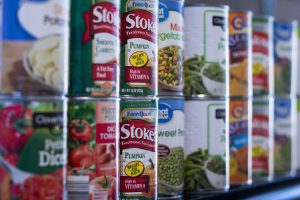
Stock up on canned fruits, vegetables, meats, and heat-and-eat soups for your hurricane food supply kit. Photo source: UF/IFAS Photo by Tyler Jones.
Now that we are officially in Hurricane Season (June1-November 30) and named storms are paying a call to the Sunshine State, it’s time to make sure we are prepared.
At the top of the list is planning meals for you and your family. Many people grab snack-type foods, such as crackers, cookies, and chips, or whatever is available on store shelves when the storm is approaching without having a meal plan in mind. Use MyPlate as a guide to plan meals to include fruits, vegetables, whole grains, protein, and dairy products. Foods from each food group provide important vitamins, minerals, and other nutrients to properly fuel your body so you are better equipped to deal with the challenges and stresses that accompany hurricanes and other disasters.
Plan a two-week supply of nonperishable or canned food and juices that require little or no cooking and no refrigeration. Include healthy snacks and any special foods for infants, senior adults, or persons with specific dietary needs. Select foods your family likes and will eat. Plan meals and shop early before a storm is on the horizon so you have a greater food selection and can take advantage of sales to stock up at a reduced cost. Keep planned written menus that have worked well for you and your family inside your hurricane food supply kit in a re-sealable plastic bag.
Brenda Marty-Jimenez, Family and Consumer Sciences Agent with UF/IFAS Extension Broward County, offers the following menu suggestions:
Breakfast Ideas
Apple juice • ready-to-eat cereal • small boxes of raisins • breakfast bars with fruit • shelf-stable skim milk • tea or instant coffee • water
Orange juice • hot cereal/instant oatmeal • banana • muffin • shelf-stable skim milk • tea or instant coffee • water
Grape juice •ready-to-eat cereal • canned peaches • yogurt • bread with jam or jelly • shelf-stable skim milk • tea or instant coffee • water
Lunch Options
Chunky beef soup (ready-to-eat style that only needs heating) • crackers • carrot and celery sticks • nuts • fruit cups packed in water • vanilla wafers • shelf-stable skim milk • tea or instant coffee • water
Canned cream soup (ready-to-eat style that only needs heating) • tuna sandwich on whole-wheat bread • tomato slices • unsweetened applesauce • cookies • shelf-stable skim milk • tea or instant coffee • water
Canned chili with beans (ready-to-eat style that only needs heating) • dinner rolls with margarine or butter • broccoli florets • canned fruit • animal crackers • shelf-stable skim milk • tea or instant coffee • water
Dinner Suggestions
Canned meat or cheese ravioli • three-bean salad (canned) • fresh yellow apples • bread with margarine or butter • fat-free pudding cup • shelf-stable skim milk • tea or instant coffee • water
Egg-salad sandwich on whole-wheat bread • canned green beans • canned fruit • fat-free pudding cup • shelf-stable skim milk • tea or instant coffee • water
Mac and cheese • canned vegetable • fresh pears • dinner rolls with margarine or butter • cookies • shelf-stable skim milk • tea or instant coffee • water
Remember the four key food safety principles: Cook, Clean, Chill, and Separate.
- Use a food thermometer to check the internal temperature of cooked foods.
- Wash hands for 20 seconds with soap and water. Sanitize food preparation and cooking surfaces regularly.
- Put leftovers in sealed bags or shallow containers and pack on ice or store in the refrigerator if it is running on a generator. Dispose of food that has been at room temperature for more than two hours (one hour if the temperature is 90oF or above) or has an off-odor, color, or texture.
- Toss out food that has come in contact with contaminated flood water. Do not eat foods from dented, swollen, or corroded cans, even though the food may appear safe to eat.
For more hurricane meal planning ideas and tips, visit: http://blogs.ifas.ufl.edu/browardco/2020/06/01/hurricane-preparedness-meal-and-menu-planning/

by Melanie Taylor | Jul 9, 2021

Some house plants are very easy to keep alive, even if you are a first-time gardener. Photo source: Melanie Taylor
As July begins, one mental health topic we repeatedly hear or read about is how stress is negatively affecting so many Americans right now. In these unprecedented times, many people are reaching out for guidance from their doctors, therapists, friends, and family. Depending on how your stress levels are affecting you, there are numerous suggestions ranging from exercise to therapy to medication and the list goes on. There may be one solution right at your fingertips that can help you begin to find a little peace of mind starting today. Gardening…. Let’s DIG IN!
Gardening does not have to be growing a large vegetable garden in the backyard. It can be planting flowers and plants in your landscape, maintaining potted plants on your front porch and deck, or growing houseplants inside your home. One easy way to start if you have never been a gardener is by growing herbs inside or out. Many people find gardening helps them escape to a place of peace as they dig in the soil and watch their plants and flowers grow and prosper.
This idea is not new. Horticulture is the art and science of growing plants. Horticultural therapy is the practice of engaging people in plant or gardening activities to improve their bodies, minds, and spirits. Research confirms that healthful benefits accrue when people connect with nature and plants by viewing and/or interacting with them.

Enjoy socializing with friends and neighbors in the garden. Photo source: Julie McConnell
Horticultural therapy has been around for a very long time. In the 1600’s, the poor often worked in gardens to pay for their medical care. Physicians quickly noticed these patients recovered faster and had better overall health than patients who did not work in the garden. Today, many hospitals, long-term care facilities, rehabilitation centers, prisons, schools, social-service facilities, and community centers use people-plant interactions as a form of treatment for persons with physical or mental disabilities. Horticultural therapy may include meeting with a therapist specializing in this area or trying something on your own or with family, friends, or a local gardening group.
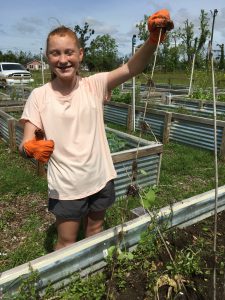
Saturday mornings are family time at the local community garden plot. Photo source: Julie McConnell
Some benefits you may receive from gardening include:
- Physical: Provides exercise at various levels. (Easy, medium, and strenuous levels – it all depends on what you decide to create.)
- Emotional: Promotes and satisfies your creative side, increases your feelings of confidence and self-esteem, promotes a new interest and enthusiasm for it, and even relieves tension.
- Physiological: May help lower blood pressure and heart rate, decrease cortisol levels, and ultimately relieve stress.
Even if you think you do not have a “green thumb,” you should try gardening on any level and see if it will be a healthy mode of stress release for you. Happy Gardening!
Source:
UF/IFAS Extension EDIS Document ENH970: Horticultural Therapy, Elizabeth Diehl and Sydney Park Brown.

by Samantha Kennedy | Jul 9, 2021
I have just wrapped up my three-day Kitchen Creations camp and am happy to report that it was a big hit with the campers. Each day had a different country theme. Day 1 was Italian, Day 2 was Mexican, and Day 3 was American. All the dishes the kids made, including dessert, represented that day’s country.
The recipes ranged from simple to more complex, allowing the kids to build on basic skills to learn more advanced ones. For some campers, boiling a pot of water was a daunting task. For others, they learned how to caramelize and julienne. The campers worked in teams to create two main dishes, a salad, and a dessert each day, which was shared with the entire group.
I am pleased to announce there were no leftovers. The kids either ate it all, or wanted to take their culinary creations home to share with their families. If that is not a testimony to the camp’s success, I do not know what is.
I also was impressed with the campers’ willingness to try new things. Many of them were skeptical about the vegetable lasagna we made on Day 1, but nearly all the kids were willing to at least give it a try. And just like the baked ziti, Caesar salad, and chocolate biscotti we made that day, there was nothing left at the end of the day.
Kitchen skills are essential for healthy living, and teaching kids how to cook when they are young provides a strong foundation upon which to continue to build.
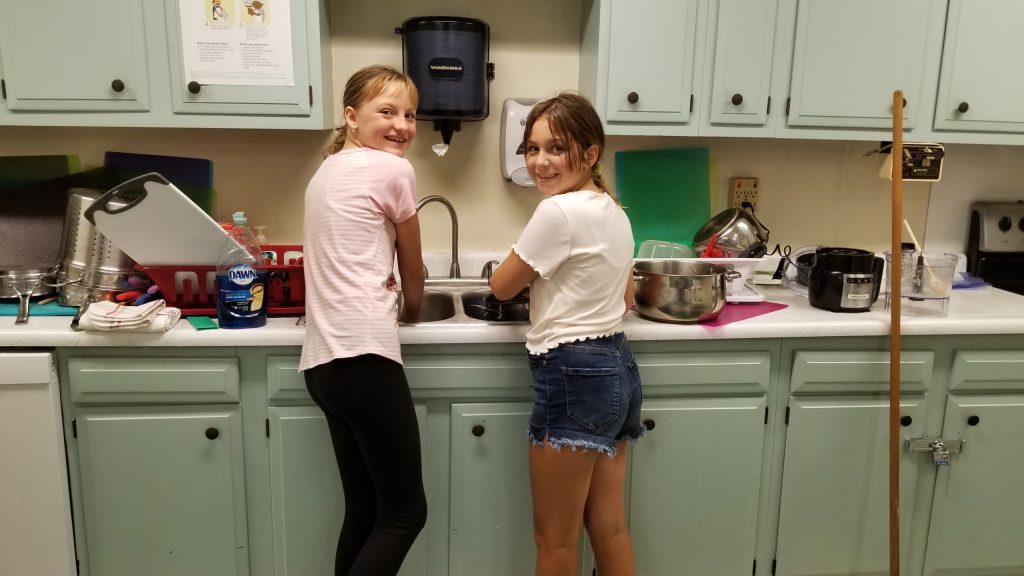
Kids can be eager helpers in the kitchen, even when it comes to cleaning up. Photo source: Samantha Kennedy, UF/IFAS Extension
Kids are eager learners in the kitchen. All the campers in Kitchen Creations were enthusiastic and ready to learn. They were proud of their creations, wanted to learn new skills, and were excited to use new tools and practice using familiar ones.
It is understandable that some parents may be reluctant to have younger kids in the kitchen. Maybe they are wary of possible injury. Maybe they are just so busy they do not have time to teach and supervise their children in the kitchen. It is a hectic world out there! But I know from personal experience with Kitchen Creations camp that kids, especially those interested in cooking, are more trustworthy and less accident-prone in the kitchen than some might expect.
The campers in my cooking camp are between the ages of 10 and 12 and in the four summers I have offered it, I have had only a few minor mishaps. The campers are aware of possible dangers in the kitchen. Things are hot. Things are sharp. Things are heavy. They are very conscientious about safety and handling things the correct way.
Kids who cook grow into adults who cook. Cooking is an important life skill that will be useful through someone’s entire life. Whether it is a student putting together quick, healthy meals and snacks to help them study, a busy parent trying to balance the responsibilities of everyday life while planning and making nutritious meals for their family, or a doting grandparent making something special for their grandkids, cooking is vital and brings people together.
Cooking is life.
I encourage you to support the budding chefs in your life. Instead of turning them away, allow them to help. Taking the time to prepare a meal together and then sharing that meal with loved ones builds stronger relationships while teaching important skills for a successful life.
UF/IFAS is an Equal Opportunity Institution.

by Claire Davis | Jun 28, 2021
How to Stay Hydrated
Here in the Panhandle of Florida, we are starting to get into the heat of the summer. With temperatures soaring, your sweat is going to start pouring. It is extremely important to replace the fluids lost through sweating. In this article we will cover what hydrated versus dehydrated means, why it is important, and tips on how to stay hydrated in the Florida heat.
What is Hydration, and Why Does it Matter?
Hydration is the process of introducing our body to additional fluid (i.e. water). Dehydration is when you have used or lost more fluid than you are taking in. Your body is unable to continue functioning properly without fluids. Staying hydrated may seem like a difficult task, but it is extremely important for us to stay hydrated for optimal health and performance throughout the day. “Drinking enough water each day is crucial for many reasons: to regulate body temperature, keep joints lubricated, prevent infections, deliver nutrients to cells, and keep organs functioning properly. Being well hydrated also improves sleep quality, cognition, and mood.” (1) Without staying hydrated, we can seriously harm ourselves. Whether you are considered a youth or an adult, you can still lose approximately 40 percent (2) of your body’s water during hard work or exercise.
How to Stay Hydrated
Drink lots of fluids: Do NOT wait till you feel thirsty to drink. By the time you feel thirsty, you are already slightly dehydrated. It is important to drink fluids, preferably water, throughout the day. During the summer, while it is hot, it should be a top priority to replenish lost fluids in our body. A good way to start the day is by drinking a glass of water when you wake up and get your body going. Some fluids are better for us than others. When replenishing fluids lost through sweating, make sure that it is mainly from water. Some of the fluids can also be from flavored water, tea, or coffee. Try not to consume as many sugar-sweetened beverages, as many of them act as a diuretic. The sugar found in these drinks tends to draw the water out of your cells, making you feel thirsty a short time after drinking it. The sugar drawing the water out of cells will also make you need to urinate more quickly, therefore losing even more fluid. Something “punny” – No matter how much soda I drink, I’m still so thirsty… I must be “soda-hydrated!”

Watermelon
Photo Source: UF/IFAS
Eat Fuel Foods: Make sure you are fueling your body with the appropriate foods. Certain fruits and vegetables contain a large amount of water. Examples of water-rich fruits are: watermelon (it’s in the name!), strawberries, peaches, and pineapples. Some examples of vegetables with a high water content are: Cucumbers, leafy green (i.e. lettuce), celery, and tomatoes. Foods that are highly processed tend to be dehydrated and have lots of sugar or salt, which dehydrates you more.
Look at the Weather: Stay inside when it gets too hot outside and when it is extremely humid. The sun is at its peak between 10 am and 2 pm every day, meaning that time is when it will be hottest outside. Plan necessary outdoor activities for the early morning or later in the evening. Also, the higher the humidity, the more you are going to sweat.
How to Dress: Make sure that you dress for the weather, appropriately. Loose fitting clothing allows your skin to breathe, keeping your body cooler. Lighter shades do not absorb the heat like dark colors. Wear a wide brimmed hat to keep your head cool. Also, use plenty of sunscreen. Getting sunburned is not just uncomfortable, it can also increase your skins’ temperature, making it hard to stay cool.
Signs of Dehydration: Be aware of the signs of dehydration. As stated above, do not wait for the signs of dehydration to begin drinking fluids. Some of the signs of dehydration include but are not limited to: dark or smelly urine, vomiting, bad breath, dry mouth, irritability, confusion, and fatigue. If you are dehydrated or have lost a lot of fluid through sweating, vomiting, or diarrhea please seek medical attention.

Water: Drink Up!
Photo Source: Ginny Hinton
Some Tips for Staying Hydrated
I have a hard time getting myself to drink plenty of fluids, so below are a few tips that I try to follow to keep myself properly hydrated.
- Keep a bottle or glass of water by your bed. While you are sleeping, your body is not receiving any fluids, so it is becoming slightly dehydrated. Having water close by the bed means you do not have to get up and disrupt your sleep.
- Purchase a reusable water bottle. If you have a reusable glass or metal water bottle, you can keep it with you all the time. If you have easy access to water, you are more likely to drink it.
- Flavor your water. Plain water can become boring if you drink it all the time. Flavor your water with some fresh fruit or a flavoring packet.
- Try to drink at least 8 glasses of “good” fluids every day. Water is extremely good for you, but you can also consume clear broth, tea, coffee, or sports drinks. This will help prevent water from becoming boring. Just make sure that you limit the intake of caffeine and alcohol.
- Check the color of your urine. Believe it or not, this can be a good indicator as to whether you are hydrated or not. The paler, or clearer, your urine is, the more hydrated you are. If the urine you pass is darker, yellow or even orange, you are more than likely dehydrated.
- Download an app. There are apps on our phones for everything now-a-days. There are apps that can send you notifications to drink more water. Some of these apps are also capable of recording how much you drink.
Staying hydrated is extremely important, especially now that we are facing the “dog-days” of summer. Drink lots of fluids, but do not wait till you feel thirsty. The more that you sweat, the more fluids you need to take in.
Sources:

by Heidi Copeland | Jun 24, 2021
“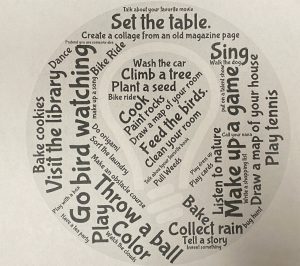
I’m BORED!” is not a statement a parent/caregiver wants to hear just days into summer break! Boredom is a feeling. The feeling of being unsatisfied or uninterested can lead to boredom. Boredom can also result from too much time on your hands. Boredom may occur when you do the same thing over and over again. Boredom can affect both physical and mental health and, let’s face it, it is not just kids who get bored!
Nevertheless, boredom, like any feeling, is important to recognize and manage. In fact, people who are good at noticing how they feel and adjusting (self-regulating) their behavior are more likely to do well in school and life, have healthy relationships, and manage difficulties and setbacks – boredom included.
How can we combat boredom? We can counter boredom with constructive activities. Constructive activities are those that require a bit of personal output, or something one actually has to do.
Therefore, before your summer vacation takes a nosedive, think of ways to ward off the doldrums. Know, too, that watching too much screen time can only make boredom worse because screen time, for the most part, is a passive type of activity/entertainment. While there is certainly a place for passive engagement (watching a movie, for instance, or reading a book), you do not have to do anything! Moreover, when the body and mind are not actively engaged for hours on end, things can go downhill… quickly. Many find actively or constructively doing something satisfying can enlighten your body, your mind, and your soul.
Think about it… while reading a book is passive, your mind is 100% active; the same goes for a movie or your favorite show. However, being engaged, like talking to someone about what you are watching or reading, takes the passive activity to a new level; talking about the activity makes it more constructive because you get really involved in it by sharing. It’s the non-participatory part repeated hour upon hour that can cause the negative effect. The body needs a balanced diet of both passive and constructive activities.
Constructive activities help activate your body, mind, and soul. So, before boredom happens, take a proactive approach to finding a solution before the problem starts. Of course, the internet is full of ideas; some of them are quite good! Personally, I like the approach where the set up requires a few easy to use resources that can quickly engage the user.
Parents and caregivers should help model the behavior they want their charges to follow. Knowing a few tricks to turn passive activities into constructive ones will help the long, hot summer be the best one yet.

by Heidi Copeland | Jun 2, 2021

A dent can lead to food spoilage in canned products.
Photo source: Heidi Copeland
It started with a visible dark line running down the pantry wall. My eye traced the dark line up to an upper shelf, only to realize a can of food was leaking. My first reaction was, “Oh, no! Botulism!” then I quickly recognized that the guilty can contained a highly acidic food, which hinders the growth of Clostridium botulinum, the bacterium that causes botulism.
A yeast more likely caused the line creeping along the wall. However, it still made for a fun afternoon of cleaning and inspecting every remaining can in the pantry.
As the photo illustrates, the can was leaking from a tiny, indecipherable breach. Perhaps there was a small dent in the can when it was purchased. Maybe it was dropped and the damage went unnoticed. However, one thing that is certain is that purchasing and storing a damaged can is cause for concern. Dents, punctures, or even rough handling can compromise the integrity of a can, which can lead to leaks and contamination.
The Food and Drug Administration (FDA) monitors the safety and integrity of canned foods. The incidence of spoilage in canned foods is low, but when it occurs, it is important to know what to do. In most cases, the best actions to take are to discard the food immediately and thoroughly clean any contaminated areas. NEVER open a bulging or leaking can. Wear protective equipment, especially gloves, when handling damaged and leaking cans.
The table below includes useful descriptive terms used in the canned food industry – it is a helpful tool for the consumer, too.
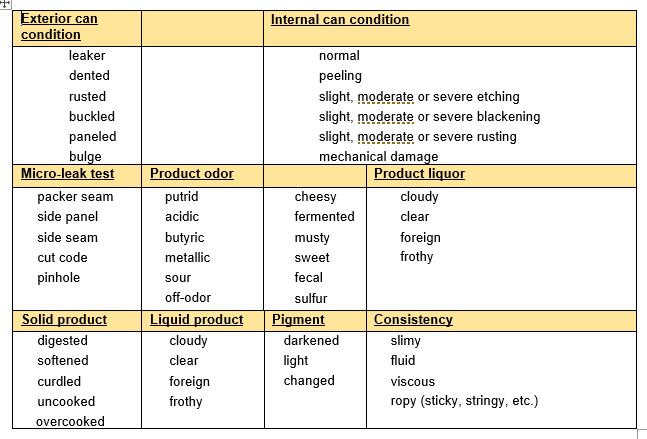
Photo source: www.fda.gov
From a cursory glance, I learned externally, my can was a leaker. The can was ever so slightly dented; perhaps the dent caused a weakness, the can rusted, and the liquid started to drain out.
Because of this canned food misadventure, my pantry got an early spring-cleaning. All the items around the offending can were removed, inspected, and thoroughly cleaned. The shelves and walls were also cleaned to remove any residue.
Cleaning the pantry should not just be done when something leaks, however. The cans and boxes in the pantry should be regularly rotated (first in, first out: FIFO) as well as inspected for pests and/or damage, and the shelves and walls should be periodically cleaned to help prevent any cross-contamination.
Other than leakage, mold, or other obvious clues that canned food is spoiled, there are other signs as well, some of which may not be noticeable until after the can is opened. Some of these include:
- The can lid does not seem attached correctly: it moves when touched or is bulging.
- The food spurts out when the can is opened.
- The can is rusting or corroded. Both rust and corrosion will eventually create tiny holes that let both air and bacteria into the food can.
- Dents: dents compromise the integrity of metal, causing a breach. Even the smallest breach in the can may lead to contamination and spoilage.
- Sound: an unnatural, loud hiss when the can is opened can be a sign of unwanted fermentation or other biological processes.
- Unpleasant smells are a good way to detect possible spoilage, even if the food still looks good.
Visual inspections are important in the food world. Do not wait until there is a mess in the pantry before taking an inventory and weeding out the old and damaged products. It is important to rotate even canned food to keep it from sitting too long. Store newer items behind older ones to ensure items are used before their expiration dates.
Resource: https://www.fda.gov/food/laboratory-methods-food/bam-chapter-21a-examination-canned-foods
For more information about food safety and proper food storage, please contact:
Heidi Copeland, Leon County Extension Office, 850.606.5229.
Samantha Kennedy, Wakulla County Extension Office, 850.926.3931
















